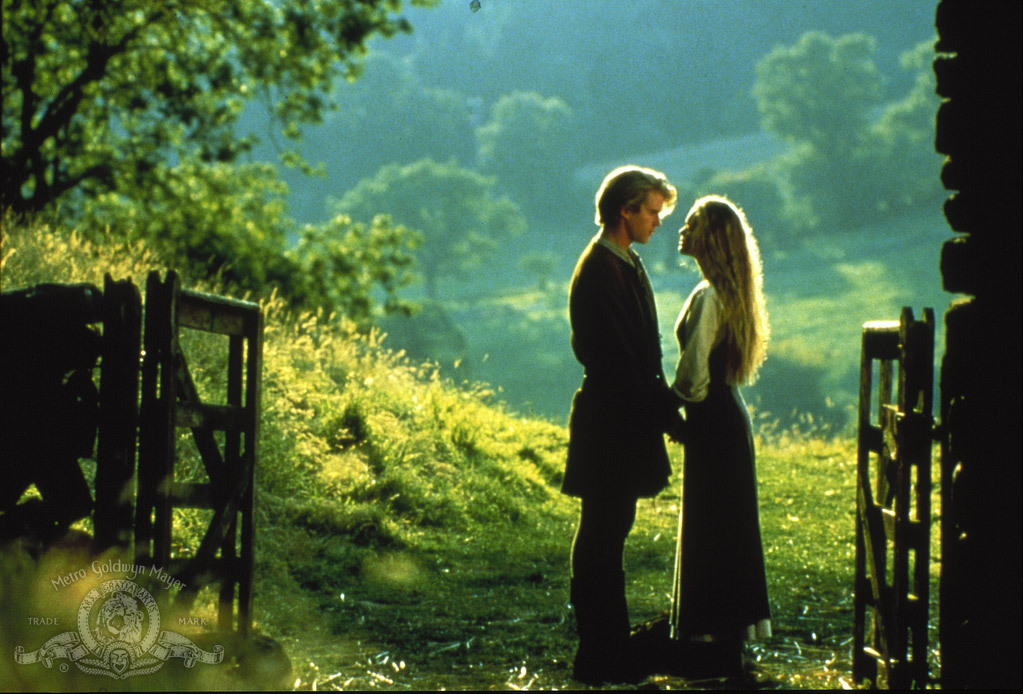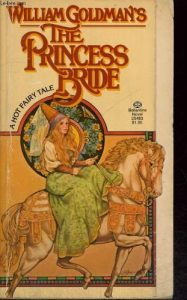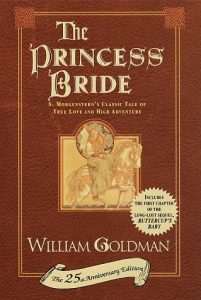
Photo source: IMDb.
We were browsing at The Open Book, Salt Lake City’s feminist bookstore, around 1977. (Even that sentence requires explanation: Tucked away in the residential Avenues neighborhood near the University of Utah, The Open Book served a disaffected progressive segment of Utah’s triply-redundant conservative patriarchal Mormon population. A year later it would close its doors after being raided by the police for selling books like The Joys of Fantasy and Men Loving Men. Both of those books were also available in other bookstores in town, but somehow when they were sold in a feminist bookstore they became pornography.)
The thrilling tale of the Dread Pirate Roberts and Rodents Of Unusual Size and the Cliffs of Insanity and the Zoo of Death.
Anyway, we were browsing, and the owner, Pam Wilson, came over and asked what we were looking for. When we answered “fiction,” she led us to a stack of mass-market paperbacks next to the register. On the cover was an over-romanticized picture of a medieval damsel on a horse. It was selling for a dollar and change.
“Don’t be fooled by the cover,” Pam advised. “It’s not a teenage fantasy. It’s like a fairy tale for adults. Everyone who’s read it loves it.” “Ring it up,” we said.
She was right. Beneath that tawdry cover, we found a thrilling, swashbuckling story. Of the beautiful and true Buttercup and her devoted farm boy, Westley. Of Humperdinck, the evil prince who coveted her, and his sadistic six-fingered henchman, Count Rugen. Of the swordsman Inigo Montoya, the rhyming giant Fezzik, and the criminal mastermind Vizzini. Of the Dread Pirate Roberts and Rodents Of Unusual Size and the Cliffs of Insanity and the Zoo of Death. Of Miracle Max and his wise wife Valerie. And of a father who reads this tale to his son, instilling in him the love of literature and the thrill of finding out what happens next.
Wait, what? I hear you say. That’s not a book, it’s a movie. The Princess Bride. A classic. It’s one of my favorites. It’s one of everybody’s favorites. And it wasn’t a father, it was a grandfather.
Well yes, of course. It’s a great movie. But, I would argue, an even better book. A book by William Goldman, the screenwriter who gave us Butch Cassidy and the Sundance Kid, All the President’s Men, and of course The Princess Bride. And in the book, it was a father.
The movie contains a story (the fairy tale) within a story (the grandfather and grandson). The book contains a story (the fairy tale) within a story (the father and son) within another story. In the outer story, the son, now a grown-up screenwriter (William Goldman), his marriage hanging by a thread, tries desperately to give his own son the same experience of hearing that tale for the first time. Complications ensue.
It’s a multi-layered masterpiece, with each layer working on its own. At its center, again, is the same inventive tale of “true love and high adventure.” But the outer layers elevate it, as Goldman suggests why such tales are critically important in the real world of “it’s complicated” relationships and humdrum daily life.
I once attended a screenwriting conference where William Goldman was a keynote speaker. The hall was mobbed with fans of the movie, but I wanted to know about the book. “Why did you omit that outer layer of story when you adapted the movie?” I asked him. “And how did it feel to sacrifice it?” He looked at me like I was crazy. “You only have two hours,” he patiently explained. “You can’t put a whole 250-page book into a two-hour movie.”
He was right, of course. And people love the movie just as it is. But to my mind, that outer layer gives the story its depth and body. It expands a fairy tale into a paean to storytelling and the power of art. And it explains, even as school kids are mowed down and the planet heats up and the republic spins out of control, why the fate of a few fictional characters, who exist only on the page and in our imagination, matters. If we care about Buttercup and Westly and Inigo and Fezzik, maybe there is hope for us after all.
John Unger Zussman is a creative and corporate storyteller and a co-founder of Retrospect.





Lovely, John. Thank you for reminding us of the power of imagination to take us away from the worries of today and the printed word can make us care about those fictional characters, even for a few hours…or for years and years.
John I’ve never seen the Princess Bride, but I am going to read that book, if I can find it. I love books with the layers and depths of life. Thank you so much for revealing this story to us.
PS. I would like to talk to you privately online, but not sure I can find your email. Could you write me(email) and I’ll write back. Thanks
Thanks, Rosie. I’m sure you can find the book at the library, but if you click on the picture of the book in the story, you can order it from Amazon. I think you would like the movie too.
Great story, John. What a wonderful discovery to find this book long before it became a cult favorite movie. And I love that you found it in Salt Lake City’s one feminist bookstore based on the store owner’s recommendation. Having seen the movie years ago, I now feel compelled to track down the book.
Oh, this is a favorite of mine as well! Have you by any chance read “As You Wish” by Cary Elwes? More great stuff related to the book and the movie. Thanks for the reminder that the book had so many layers and created a world of its own. Have fun storming the castle!
Your comment made me smile. I’ll add the book to my to-read list.